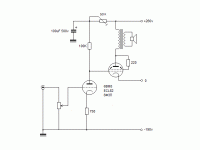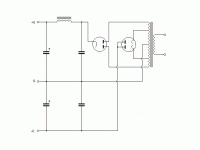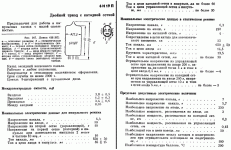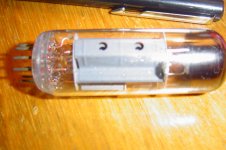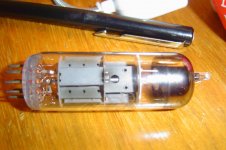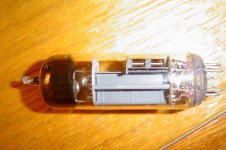Yes, it takes about a week to make one good transformer. But only your own transformer works as good as carefully you made it
try to find good laminates and finish the windings and calcs by yot own work... might go cheeper a bit...
google for "Wasner" core laminates I think that is 15 EU per Kg
permeability of about 800 (classic is 400 acc.)
allowing the less number of turns for high prim ind.
and lower capacitance...
.
But prepare to loose a day just to cut and finish isolation papers...

I usually use a vintage transformer cores.
Gleb.
Maybe one of these days but I dont have much time to do things like that and I have to study the question thoroughly ...Have you tried to make your own output transformers ? It's really not very difficult, and it does not require winding machine - handmade is really better !
Gleb.
What I really like to do is finding good and low cost tubes I can use with all the output transformers I already have home, I got over 20 pairs of all kinds but mostly little "cheaps" SE types I found in vintage tubes amplifiers, radios, tv and tape recorders ... That's where I get all my tubes too, I got hundreds of them, I found 22 Amperex 6DJ8 just in one old Tektronix scope, a real gold mine of parts, there is about 80 tube all good for audio in that heavy monster ...
The best output transformers I have come from a Eico ST-40 using 7591A power pentodes ... I keep them for my future personnal living room sound system but I like to use other kinds of tubes because the 7591A are rare and too expensive for my budget.
Thank you for the tip !
But I wonder if they can sale small quantity to particular customers.
Tiens, un Québékouais !Hi Alain,
As previously discussed many times before on this forum, do yourself a favor and use a pentode as a driver instead of a triode. This is the best way to implement a Schade feedback even though I tried it many time and did not see a real improvement. Some of the members on this forum sware by this ;-)
Rgds,
Eric
C'est là-dessus que je travaille actuellement avec mon simulateur, je fais des tests avec une 6AU6A comme driver pour la 6S19P mais c'est beaucoup de travail ... Je prévois aussi en utiliser comme préamp connectées en triodes parce que j'en ai à peu près une cinquantaine à rien faire sur mes tablettes ...
Lorsque j'aurai trouvé quel circuit fonctionne le mieux même avec des transfos "bas de gamme", je le ferai connaitre dans ce fil aux membres de ce forum. Le gros problème avec les 6S19P est que leur "résistance dynamique de plaque" est vraiment très basse, je l'estime à seulement 566 ohms ...
C'est tellement bas que ça réagit mal avec la plupart de transformateurs de sortie à moins que leur primaire ait une inductance assez élevée pour les basses et surtout un "coupling" presque parfait pour les aiguës ... Ça doit être pour ça que les russes vendent ce tube quatre pour 10$ sur eBay, ils sont très capricieux à utiliser !
À propos, tu connais les 6S7B ... Elle ont l'air un peu bizarres car elle sont du type "sub-miniature" avec broches en ligne mais elles ont des courbes vraiment magnifiques et coûtent presque rien sur eBay, je crois qu'elles peuvent "accoter" les meilleures triodes au monde ...
Sorry for the french guys !
That is something I have, a lot of big used transformers ... There are some huge ones in the microwave ovens you can sometime find in the garbages on the sidewalk ...Yes, it takes about a week to make one good transformer. But only your own transformer works as good as carefully you made itIt will remember your tired hands and will delight you by excellent sound !
I usually use a vintage transformer cores.
Gleb.
If I ever decide to wind my own transformers, "output" but also "power", I will build a DIY winding machine first ... I like building machines, I go back to school 1800 hours to get an "electromechanic" diploma three years ago and I learn many things about metal working, bearings, gears, chains, motors, pneumatic, hydraulic, arc and gaz welding, automatisation and industrial electricity and electronic ... It was very funny but at my age, it is very hard to find a good job, I think I will have to start my own little business for the few working years I have left before my retreat ...
I found 22 Amperex 6DJ8
6BM8 is a very good tube ! Do you have them ? I use it in this schema (please look attachments):
With anode load 4-5K this amp gives with 2,5W power about 0,5% of 2nd harmonic. 3rd harmonic is so small that it is not defined by my devices
Attachments
Last edited:
6BM8 is a very good tube ! Do you have them ? I use it in this schema (please look attachments):
With anode load 4-5K this amp gives with 2,5W power about 0,5% of 2nd harmonic. 3rd harmonic is so small that it is not defined by my devices
you are missing cap on input , for start
Do you mean Google Translator is needed to translate tetrode picture to pentode?
You should count grids. Tertode has 2 grids, pentode has 3 grids.
Attachments
I like the way they put the -190V to ground, after all, this is a floating supply and no coupling capacitor is needed !6BM8 is a very good tube ! Do you have them ? I use it in this schema (please look attachments):
With anode load 4-5K this amp gives with 2,5W power about 0,5% of 2nd harmonic. 3rd harmonic is so small that it is not defined by my devices
Thank you but I already got many mechanical ones in my "junkbox", they where used in tape cassettes recorder. I can also buit a digital one very fast, I got all the parts for that, TTL counters, 7 segments display and small encoders.Hey if you go to build your machine for winding, you can have one of my Sodeco counters. (I have three) It's got 5 digits, 12v and rated for 10 impulse per second. They all seem to work fine.
You pay the postage.
Al
I am not only interested in audio DIY but any kind of electronic, for motor drive, PIC microcontrolers circuits and programming, battery chargers, robotic and automation, etc ... I work as technician in many electronic company since 40 years and I learn a lot of things.
Alain.
Zibi;
we discussed it already, but did not come to conclusion, who made a mistake: who wrote description in the datasheet, or who drew the picture. Sacrifice is needed to check what is inside, or at least X-Ray picture.
Sorry for resurrecting this thread from the dead, but IMO it deserves it as contains such a lengthy discussion on the pentode vs. beam power tetrode and I can add a proper (documented) closing to it.
No need for sacrifices though. I have got a batch of this 6F5P and can confirm that it is a beam power tetrode. The beam forming electrode is clearly visible through the holes in the anode, as also is the lack of the g3 supporting rods on the top and bottom of the assembly. I will upload photos tonight.
Gaston
6F5P Photos
Crappy photos, I know, but better than nothing.
In the first one one can see the beam forming electrode right under the anode structure. Same material as the anode itself-
In the second one can see the screen grid (g2) supporting rods through the hole in the anode.
The third photo shows (badly) the grid supporting rods protruding through the top mica disc. g1 and g2 only. The getter is supported by extensions of the anode.
BTW this specific tube was made in 1985 at the "October" plant, in Ukraine.
Gaston
Crappy photos, I know, but better than nothing.
In the first one one can see the beam forming electrode right under the anode structure. Same material as the anode itself-
In the second one can see the screen grid (g2) supporting rods through the hole in the anode.
The third photo shows (badly) the grid supporting rods protruding through the top mica disc. g1 and g2 only. The getter is supported by extensions of the anode.
BTW this specific tube was made in 1985 at the "October" plant, in Ukraine.
Gaston
Attachments
- Status
- This old topic is closed. If you want to reopen this topic, contact a moderator using the "Report Post" button.
- Home
- Amplifiers
- Tubes / Valves
- What mean those russian electronic units ?

